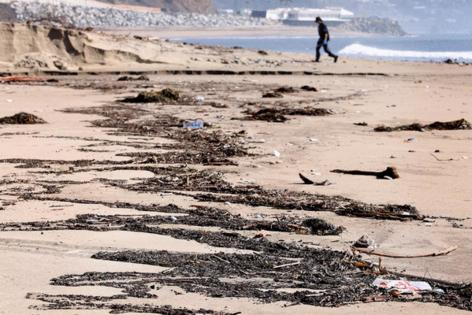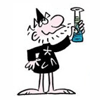Fire debris is washing up on LA's beaches. County officials warn the public to steer clear
Published in News & Features
LOS ANGELES — The gunk has turned up on shorelines from Malibu to Redondo Beach: ghostly lines of charred black bits and melted debris left behind by retreating waves.
It's a mix of ash, sand and pulverized flecks of burned wood and plastic, material destroyed during January's fires and then washed into the sea by recent rains.
The county Department of Beaches and Harbors declared last week that the stuff was "not hazardous to beachgoers or the environment," based on initial testing of samples taken from Will Rogers State Beach and Topanga Lagoon in late January.
The department also said that the sediment won't be removed under the county's ongoing efforts to clear fire debris from shorelines.
"Attempting to scrape it from rocks and sand could destroy marine habitats, erode the shoreline, and cause long-term environmental damage," the department said in a statement. "Instead, natural tides and weather will gradually break down and wash away the sediment, allowing the ecosystem to recover naturally."
Initial testing by the Department of Public Works found that heavy metals, petroleum hydrocarbons, chlorinated pesticides, polychlorinated biphenol (PCBs), volatile and semi-volatile organic compounds, and asbestos were below levels that would characterize the debris as hazardous waste.
The county is still advising beachgoers to steer clear of visible fire debris. Local environmental groups also urged caution.
"Risk tolerance is a deeply personal choice and right now the limited data that has been shared hasn't identified concentrations of contaminants that pose a health risk," said Tracy Quinn, president of the environmental nonprofit Health the Bay. "I personally will be waiting until additional lab results are back before getting in the water between Santa Monica State Beach and Dockweiler."
The combination of last month's fires and ensuing heavy rains sent unprecedented amounts of ash, debris and chemical residue coursing into the sea via the region's massive network of storm drains and concrete-lined rivers.
The Los Angeles Regional Water Quality Control Board is working with the county to test ocean water near areas affected by the fires, which burned more than 40,000 acres across the L.A. region last month.
Unlike rural wildfires fueled by organic material, the Palisades and Eaton fires consumed homes and businesses. Flowing into the sea are the burned remnants of cars, plastics, batteries, household chemicals and other potentially toxic material.
"I don't think there's a precedent for this kind of input into the ocean ecosystem," marine biologist Noelle Bowlin said at the time.
In late January, county public health officials deemed ocean water off-limits to beachgoers from Las Flores State Beach in Malibu to Santa Monica State Beach, citing concerns about potential toxic or carcinogenic chemicals in the sand and water.
Even after the closures were downgraded to advisories, health officials warned the public to stay away from fire debris in the area, noting that runoff flowing onto or pooling on the sand could contain harmful substances.
Within days of the fires' eruption, ash and charred debris carried by the winds littered the ocean's surface as far as 100 miles offshore. Wind and waves have since distributed charred material down the county's coastline.
County agencies said the initial sediment testing that the beaches and harbors department has referred to was conducted by the Department of Public Works after Jan. 26, when the region saw its first rainfall in nine months.
The water board has said it is planning in coming weeks to test the dark sediment accumulating on the beaches for fire-related compounds such as heavy metals, PCBs and polycyclic aromatic hydrocarbons (PAHs).
The latter two are endocrine-disrupting chemicals associated with health problems in humans and wildlife.
As part of its ocean monitoring efforts, the water board already collected seawater samples on Jan. 22, Jan. 27, Feb. 6 and Feb.18 to analyze for heavy metals, bacteria, PCBs and PAHs.
"These are chemicals that we expect to see in water runoff after a fire, based on all of our experience with previous fires in California," the water board's assistant executive officer, Jenny Newman, said during a Feb. 18 town hall organized by the public health department.
Though data isn't back from the most recent testing date, the first three rounds showed lower-than-expected levels of lead, cadmium and other heavy metals, the board said.
The samples also came back with levels of PAHs and naturally occurring metals such as iron, manganese and selenium that were above water-quality standards, the board said. All are substances typically found in wildfire runoff, and the board expects to see levels decline over time, Newman said.
Once testing of the sediment starts, "we're going to sample the beaches for as far away as where dark sand is being observed," Newman said. "We'll share that data with the public when it's available."
©2025 Los Angeles Times. Visit at latimes.com. Distributed by Tribune Content Agency, LLC.







Comments